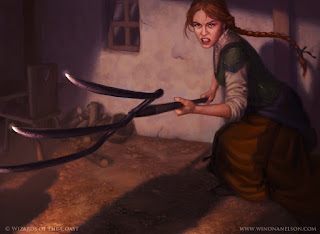Much like the Fighter, I’ve smooshed all the magic classes together into a single class. Except for Illusionists, because I don’t like Illusionists and they have no place in the setting I’m developing. Also Bards. Bards can suck it.
While the title of this class is Magic User, you can write in whatever you want on your character sheet; Wizard, Cleric, Druid, Summoner, Magus, whatever. You will notice that Clerics do not automatically know every spell of a given level. Why should they? They need to study and memorize prayers and keep a prayer book just like a Wizard needs to study and memorize spells and keep a spell book.
Spells will either be condensed into a single list, or players can choose to go with one of the traditional lists. I’m seriously considering incorporating magic Circles from Palladium Fantasy. I think it would add something cool and different. On the other hand, it would also add a level of complexity, which is what I want to avoid. So ignore that bit for now.
Anyway…
Prime attribute: Player’s choice of Intelligence or Wisdom
Hit Die: d4
Abilities:
- Starting Spells: 3 level one, 2 level two, 1 level three.
- Cost to cast: 1 Hit Point per spell level, per level of current Encumbrance.
- Note about Class Skills: unless chosen/rolled from the list below, the Magic User has a base of 18 on any skill check. Level bonus does not apply, although attribute modifiers do apply.
Humans choose two of the following abilities every level of experience, non-humans choose one:
- Increase Hit Die by one type. So your d4 is now a d6. Hit points are not re-rolled.
- Increase a Prime attribute by 1 point, up to racial maximum.
- Natural Aptitude: Learn a spell equal or less than your own level. No research needed.
- Decrease casting cost by 1 HP, after multiplication. Minimum casting cost of 1 HP. So, if you’re lightly encumbered and have this ability, your cost to cast a spell is 2 HP per spell level, -1.
- Create Scroll (as per LotFP). Roll this again and the cost and time is reduced by 10%
- Create Potion (as per LotFP). Same as number 5.
- Your hand eye coordination is better than average: +1 to hit.
- Enlarge: Range and Area of effect of spells is increased 25%
- Power: Duration of spells is increased 25%, and damage is +1
- Reach: Spells with a range of Touch can be extended 5 feet from the caster.
- Cantrips: Learn two Level 0 spells. These cost 1 HP regardless of encumbrance level.
- Saving Throw bonus: +1 to all non-prime saves.
- Duck and Move: +1 to Armor Class
- Retroactive Magic Detection: Detect magic used in past 24 hours in a 30 square foot area, with a Wisdom check. Roll this again and you can determine what spell was cast. Roll it again and you can detect if a magical creature or magic user of 5 HD or higher passed through. Roll it any more times and you get a +1 to your attribute check.
- You automatically see the aura of any creature of 1 HD or less. Roll again and this increases to 2 HD or less.
- Enchant Object: Magic rings, wands, talismans, etc. Same as number 5.
- Pick or roll an ability from the Fighter or Specialist ability lists. This is your chance to multi-class!
- Choose a class skill from the following list: Climb (STR), Decipher Script (INT), Listen (WIS), Swim (CON), Move Silently (DEX), Hide (DEX), and Language (INT). Class skills receive a bonus equal to your level, as well as attribute modifiers.
- Choose a 1st level spell that you already know. You can cast this spell 1x per day at no hit point cost.
- Counterspell: When another magic user casts a spell against you, or anyone within 10 feet of you, you can roll a save vs magic to counter it, and send the spell back at its caster. Every time you re-roll this, you get a +1 to your save.










